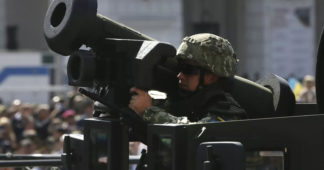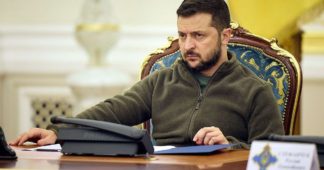By Jason Melanovski
The Ukrainian government is considering conscripting an additional 500,000 men in response to a request from the Ukrainian Armed Forces, President Volodymyr Zelensky announced on Tuesday at his end-of-year news conference.
The proposed mobilization plan would cost $13.3 billion, according to Zelensky. He admitted that it is unclear how exactly Ukraine, already Europe’s poorest country, would pay for the mobilization. During his trip to Washington last week, he failed to secure the immediate approval of $60 billion in US funding from Congress.
With a total pre-war population of approximately 36 million, of whom millions have left the country, the proposed numbers would represent a huge share of the working age population. They would be brought to slaughter bench in a NATO-provoked war that was described as a “stalemate” by Ukrainian General Valery Zaluzhnyi in November of this year in The Economist.
The total number of Ukrainian soldiers already killed or injured in the war is a closely guarded secret by Kiev, but Zelensky’s former presidential advisor Alexey Arestovich confirmed Russian claims of 400,000 Ukrainian casualties during an interview earlier in December.
According to the UN, over 10,000 Ukrainian civilians have been killed, 560 of them children. Ukraine is now also the most heavily mined country in the world.
While Zaluzhnyi was strongly criticized by Zelensky and his advisers in November for describing the war as a “stalemate,” in reality, this appears to have been a charitable characterization, as Ukraine has lost 20 percent of its territory since the start of the war in February 2022, including its major shipping ports on the Black Sea. Many military analysts consider it highly unlikely that Kiev can retake Crimea or the Donbass region.
The much publicized spring “counteroffensive” was an abject failure, with no territorial gains and a reported loss of some 125,000 Ukrainian troops in just a few months time. A large portion of the expensive Western military equipment that NATO had delivered to Kiev was useless or went up in flames. Throughout the country, Ukrainian forces are now largely on the defensive and at risk of losing the strategically important city of Avdiivka northeast of Donetsk, which has turned into another “meat grinder” like Bakhmut in which both sides sacrifice untold numbers of troops in suicidal attacks for inches of land.
As the war drags on, Russia’s numerical and material advantage is increasingly becoming clearer as Lieutenant General Ihor Romanenko, former deputy chief of the General Staff of the Ukrainian Armed Forces, recently told Al Jazeera.
“These days, we are focusing on switching to defense, and, to boost its effectiveness, to equipping and mining the most threatening [front-line] areas and use this time to amass resources,” Romanenko said.
In regards to military production, Russia’s rapid buildup of artillery and other armaments production over the past year is clearly having an effect on the battlefield. “This year, [Russians] managed to catch up with us and go ahead of us, and to produce large quantities of unmanned aerial vehicles,” Romanenko said.
Under these conditions, the call for the mobilization of 500,000 Ukrainian citizens is a tacit admission that the Zelensky government is prepared to sacrifice hundreds of thousands more in its bid to retake territory in Eastern and Southern Ukraine which in addition to its industrial and agricultural significance, is home to highly valued mineral deposits.
The Zelensky government is rightfully worried about a backlash from working class Ukrainians who will be forced to give up life and limb in the war. It has called the mobilization push “a very sensitive issue” that has yet to be decided on before sending it to parliament for ratification.
Polls from the Kyiv International Institute of Sociology show that some 65 percent of the Ukrainian population supports further mobilization. However, these figures should not be trusted as any opposition to the pro-war nationalist propaganda in Ukraine is highly censored, and participants would be unlikely to give honest answers for fear of a visit from the country’s Security Services (SBU). As Anton Hrushetskyi, the executive director of the Kyiv-based polling agency, himself told Reuters, Ukrainians often give “socially desirable” answers or give false names to protect their identity.
A rapid increase in conscripted soldiers also risks alienating the Ukrainian upper and middle classes who have largely been shielded from the war by either fleeing the country, exploiting student or medical deferments, or paying up to a reported $10,000 in bribes to avoid conscription, a huge sum that would be simply out of reach for working class Ukrainians.
In August, Zelensky fired the heads of Ukraine’s regional recruitment centers after a large-scale bribery operation was uncovered. By doing so, he inadvertently caused a rapid decrease in conscription numbers, angering the military and furthering a growing rift between the government and the military led by Zaluzhnyi.
On Monday, prior to Zelensky’s press conference, Zaluzhnyi openly criticized Zelensky’s firing of the recruitment leadership and blamed the conscription failures squarely on the Zelensky government. “These were professionals, they knew how to do this, and they are gone,” Interfax Ukraine quoted Zaluzhnyi as saying.
With a military crisis staring them squarely in the face, recruiters have increasingly resorted to dictatorial methods of grabbing young people from gyms, restaurants, malls and off the street and forcing them into the army as the WSWS reported last spring and the New York Times belatedly admitted last week.
As its domestic population of suitable recruits continues to dwindle, this week newly appointed Ukrainian Defense Minister Russian Umerov announced plans to force Ukrainian men living abroad back to Ukraine to serve in the armed forces. As BBC Ukraine reported in November, 650,000 Ukrainian men aged 18-60 have left Ukraine for Europe since the start of the war, while Zelensky’s former adviser Alexey Arestovich recently claimed that 4.5 million Ukrainian men, nearly half of the Ukrainian male population, had fled abroad to avoid military service, and that 30 to 70 percent of military units consist of “refuseniks,” who have gone absent without official leave (AWOL).
To force unwilling soldiers back home, “invitations” will be sent out to the potential recruits who may then face “sanctions” should they not return. “We are still discussing what should happen if they do not come voluntarily,” said Umerov.
We remind our readers that publication of articles on our site does not mean that we agree with what is written. Our policy is to publish anything which we consider of interest, so as to assist our readers in forming their opinions. Sometimes we even publish articles with which we totally disagree, since we believe it is important for our readers to be informed on as wide a spectrum of views as possible.











